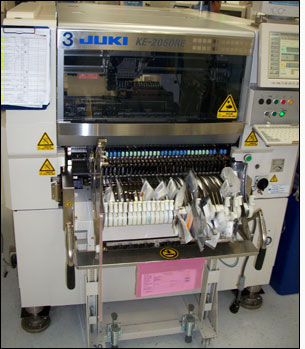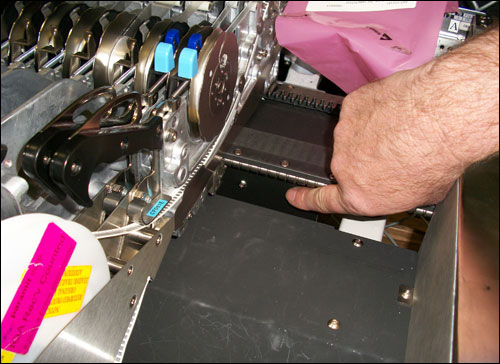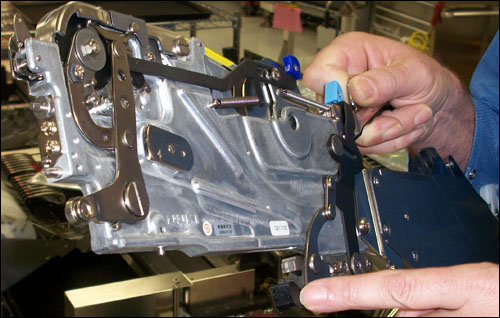Mar 15, 2010NBS Corp., a Santa Clara, Calif., manufacturer of circuit boards, has begun using radio frequency identification to track which components are installed on the boards it assembles. By monitoring this information, the company is able not only to ensure that a component is not being installed in the wrong location in the first place, but also to store data regarding those assembled circuit boards in the event that a component fails or is recalled by its manufacturer. To RFID-enable its assembly machines—which are provided by Juki Automation Systems—NBS is employing RFID tags, interrogators and software from Cogiscan.

NBS provides circuit boards for a variety of equipment users for which, in many cases, the proper operation of those boards is critical. One example is the medical device industry, for which the firm provides circuit boards for implantable devices, such as pacemakers. These are the boards of the most immediate concern, says Peter Chipman, NBS' director of testing.
When components arrive at the assembly plant, they come packaged in a format known as a "tape and reel." The reel is designed to feed the components to the automated placement machine that will place them on a circuit board. Each reel of components is identified with a bar-coded label containing a serial number that relates to the part number, lot number, quantity and other component-specific information, all of which is stored in a central database.
The company employs a rigorous set of checks and balances, Chipman says, to ensure the circuit boards—which may contain 100 to 200 components, such as resistors, capacitors, switches and LEDs—are properly assembled. That includes having several employees look closely at the component reels' placement, in order to ensure that each is installed in the proper slot of a trolley that is then inserted into a circuit board assembly machine. In that way, the firm can ensure the components are in the correct location for that type of board.
After being assembled, the boards go through a series of checks by employees to again make sure the proper components were installed. Because the company typically builds 5,000 boards of a variety of types in a single day, the machine's settings and the reels installed in its trolleys often need to be changed, thus making the process that much more complex. If a particular component fails and is recalled by its manufacturer, it could be difficult for NBS to determine where the component came from, and in which batch it originated. It could also be difficult to track which circuit boards have that component in them.
The company is using Cogiscan's RFID technology in conjunction with the Juki IFS-X2 Intelligent Feeder system. Prior to production, each reel is loaded into its own tape feeder—a fixture designed to present the components, one by one, to the machine as they are required during assembly. Each tape feeder is identified with a serialized bar-code label, and has a low-frequency (LF) 125 kHz RFID tag that employs a proprietary air-interface protocol. When the reels are loaded onto the feeders, the operators utilize a handheld device to scan the bar-code labels on each reel, as well as on the feeder, to link them together in the database. As a second step, when the feeders are loaded on a trolley, their tags are read by an RFID interrogator by means of an array of small antennas (one for each feeder slot) mounted on that trolley. The interrogator reads the tags' unique ID numbers, and then sends that information to the software in the company's back-end system, which determines in which slot the reel has been placed, based on the location of the antenna that reads that tag's ID number.
During assembly, says Francois Monette, Cogiscan's co-president, each circuit board is printed with a bar-coded serial number that is scanned by a camera mounted on the machine. This enables the company to maintain a record of which board receives components from which reels, as well as where on the board those components are installed, based on the slot in which each reel was placed.
"At the end of the building process, if everything is okay, it [the system] will write all the data into a file with the board's serial number," Chipman says, and the company can then store that information for future reference, in the event that a component fails or is recalled.
"We're starting off by targeting the solution for medical device companies," Chipman states. The company's customers have agreed to pay more for the product, he adds, to offset the cost of the new technology. The system is not designed to save labor hours, Chipman notes, but rather to provide a record of the components installed on any given circuit board. "The price of one lawsuit based on a bad component," he says, would be greater than the cost of the new system.
The company is initially employing the system on one of its five assembly machines, to track data regarding components on circuit boards made specifically for medical device manufacturers. However, Chipman says, if the system continues to work properly, the company intends to install it on all of its assembly machines.




